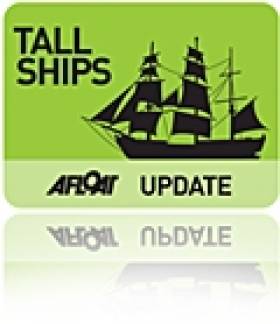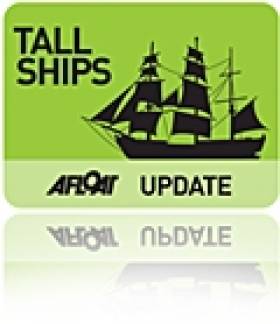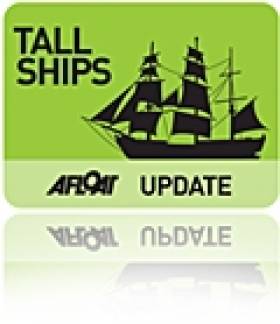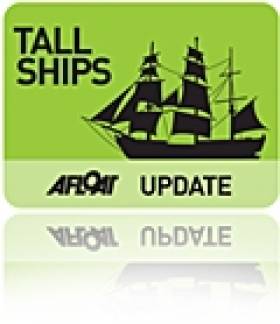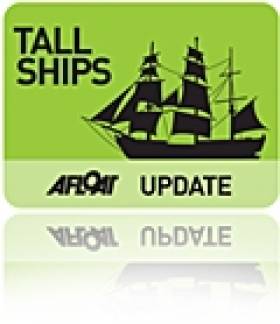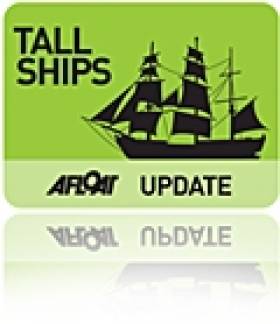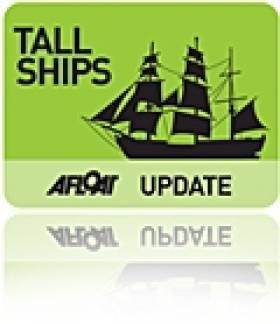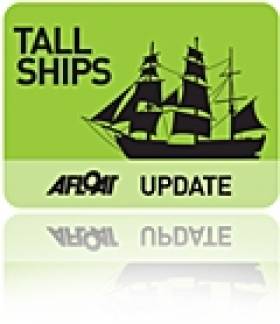Displaying items by tag: Tall Ships
#tallships – A new venture for Oysterhaven Activity Centre in County Cork is its offering of adventure sail training on board the classic schooner Spirit of Oysterhaven. These 5 day voyages, designed either for youths (16 - 20 yrs olds) or adults start in Glandore and cruise the spectacular south coast, anchoring overnight in idyllic harbours of West Cork such as Castletownsend, Baltimore, Schull and Crookhaven.
Centre principal Oliver Hart says it is a great opportunity for aspiring sailors to get to know the ropes and sail on board the 70–foot classic schooner.
Crew members can expect to be fully involved in the sailing of the ship, from hoisting sails, to grinding winches to steering a course.
A highlight of previous voyages this summer has been rounding the Fastnet and a night sail back to Oysterhaven. As well as sailing the boat crew members will work together to produce meals, wash -up and keep the boat ship shape - useful skills to bring home!
Skipper Tom O'Leary is an experienced Yachtmaster Instructor and ensures that during the voyage crew members put into practice all the essential elements of sailing theory, from passage planning, to studying the weather, predicting tides and navigating to the desired destination.
August 12 - 16th and August 19 - 23rd
Cost € 450
Mediterranean Regatta
The Mediterranean Tall Ships Regatta is a chance to join the Spirit of Oysterhaven Trust Ltd for an unforgettable cruise in the company of a fleet of Tall Ships from Barcelona in Spain to Toulon in France and finishing in La Spezia in Italy.
With our focus on providing opportunities for disabled sailors to share the experience of sailing we have reserved two berths on each of the voyages. Funding is available for some crew members under the Sultan of Oman Bursaries, please contact for details.
Voyage 1 Sat 21st Sept - Friday 27th Sept. Barcelona - Toulon
After a festive Tall Ships event in Barcelona from September 21st to 23rd, the fleet sails for Toulon in France on Tuesday 24th September, arriving in Toulon on Friday 27th to enjoy a couple of days of French hospitality.
Voyage 2. Sat 28th Sept - Fri 4th Oct Toulon - La Spezia
Departing Toulon on Monday 30th September the fleet sails for Italy, arriving on the 4th October for a festive week-end in La Spezia.
Rates € 700 per person per voyage (€1,000 for 2 voyages)
Note that these voyages are run under the auspices of the Spirit of Oysterhaven Trust Ltd, a "not - for -profit" company established to promote education through sail training for young people of all abilities and social backgrounds. See http://www.spiritofoysterhavensailing.ie/spirit-of-oysterhaven-schooner-cork/spirit-trust
Milebuilding Voyage
Candidates considering doing their Yachtmaster exam any time soon may like the opportunity of logging some qualifying miles on a shared expenses basis. Spirit of Oysterhaven will be heading down to Portugal in late August. This 10–day voyage will give crewmembers the full experience of offshore sailing and ocean navigating. After the crossing of the Bay of Biscay Spirit will make a brief stop in Baiona, Spain before heading on down to Lagos in Portugal. This 1,000 mile 10 day voyage starts on August 28th and ends on 6th September.
Mid September Spirit sets out from the Algarve for a sunshine delivery cruise to Barcelona, with a brief stopover off at the Balearics - Mallorca and Minorca. This voyage is 750–miles and will involve more stops along the Spanish coast. Starts 12th September and ends in Barcelona on the 21st. Crewmembers may join for shorter sections of this passage.
Thieves Raid Astrid Wreck Under Cover Of Darkness
#Astrid - The ship's bell and compass are among the items stolen in a dastardly raid on the wreck of the tall ship Astrid near Kinsale, as The Irish Times reports.
Owner of the near-century-old brig Pieter De Kam said that while he is "eternally grateful to the Irish people" for the rescue of all 30 crew on board when the ship struck rocks last Wednesday (24 July), he is "not grateful to whatever Irish people have gone aboard my ship and stolen my compass, my bell and my binnacle".
Breaking the exclusion zone set up around the tall ship - which went down after striking rocks and taking on water in strong winds and heavy seas while taking part in The Gathering Cruise - it appears the thieves slipped in by nightfall at low tide last Friday night (26 July) to grab their ill-gotten loot.
Though the 42-metre sail training vessel remains mostly intact, despite her ordeal, in the water near the Sovereign Islands off Ballymacus Point, it is unlikely that she will sail again due to the severity of damage to her hull.
Astrid Repairs Unlikely As Experts Discuss Salvage Plans
#Astrid - The Irish Times reports that marine salvage experts met on Friday with insurers of the Dutch tall ship Astrid to determine a wreck removal plan for the sunken vessel.
The sail training ship, which was taking part in The Gathering Cruise around Ireland, capsized after hitting rocks inside the Sovereign Islands near Kinsale in Co Cork on the afternoon of Wednesday 24 July.
All 30 crew on board - including a number of teenage sail trainees - were brought to safety by RNLI lifeboats from Kinsale and Courtmacsherry in a major rescue operation.
As previously reported on Afloat.ie, investigations got under way last Thursday 25 July to determine what caused the 42-metre brig to run aground at the mouth of Oysterhaven harbour.
Despite strong winds and rough seas at the time of her foundering, the Astrid remains largely intact apart from rips along the hull.
And according to expert salvage diver Colm Harrington, the 95-year-old ship will be salvageable - using slings to lift the vessel from the water.
However, the severity of the damage sustained means that it's unlikely the Astrid will be restored to her former glory.
The Irish Times has much more on the story HERE.
Tall Ship Astrid Sinking Investigations Underway
#tallshipsinking – The hull of the 42–metre–long Tall Ship Astrid appears to remain largely intact on rocks off Kinsale this afternoon, some 24 hours after the Dutch brig foundered during an Irish Sailing Association (ISA) parade of sail at its 'Gathering' Cruise yesterday. The accident now looks likely to be the focus of at least two separate enquiries, according to Afloat sources. News of the accident broke on Afloat.ie yesterday.
An exclusion zone has been set up around the wreck this morning for safety reasons as the Coast Guard assess the damage and wait to hear what action the owners of the Astrid plan on taking. There are a reported 3.5 tonnes of diesel on board Astrid and there is a pollution concern if the ship broke up. Divers are expected to examine the ship today.
There is speculation that a salvage attempt may be possible. The ship appears to be stuck fast on the rocks with little movement in the swell at the mouth of Oysterhaven harbour.
This afternoon the stern of the hull is clearly visible, with three inflated liferafts, lifebuoys and a dinghy still tethered. Both masts and rigging appear intact and sails furled or partially furled. An Irish tricolour courtesy flag is also still flying from the foremast, flown as a token of respect by this visiting vessel to Irish waters.
Both Dutch and Irish Marine Casualty Investigation Board (MCIB) inquiries are likely after the Failte Ireland backed 'Gathering Cruise' ran into difficulties with the total loss of the 1918-built Astrid as it made its way along the Cork coast yesterday at noon. It is the same spot where the barque Falls of Garry sank in 1911. (See google map below).
A Mayday call after an engine failure prompted a massive air sea rescue operation as desperate efforts to tow the vessel away from rocks by event organisers failed.
A text book rescue of all 30 people on board was completed when four RNLI lifeboats arrived on scene off Kinsale, County Cork. Winds were southerly and blowing up to force five with a four metre swell hampering the evacuation, according to John Leahy, a participant on the cruise.
A major emergency plan was activated in Cork and a medical emergency team was also on standby at Dublin airport.
As well as Cork lifeboats, the Navy's LE Emer and two Coastguard helicopters were involved in the rescue.
Irish Sailing Association (ISA) organisers have thanked rescue services for their rapid response in saving all 23 trainees and seven crew on board.
Teenage trainees on board the vessel were said to be shocked, but no was hurt.
The square rigger was leading a parade of sail for photo opportunities when it reported engine failure.
The captain tried to use the ships sails to manoeuvre away from rocks near Prince's Grave near the Sovereign islands. Reports say there was a 4m swell and force four to five southerly wind blowing.

A Rib in the foreground monitors the wreck site and a vehicle is visible on the edge of the field directly above the site. An exclusion zone has been set up around the ship. Photo: Bob Bateman
The ISA's Harry Hermon described in a statement last night how he attempted to throw a line to the foundering ship.
A Marine Casualty Investigation Board (MCIB) report is now most likely to establish the facts surrounding the accident but Dutch authorities are also expected to carry out an inquiry as a standard procedure.
Last night, the Gathering Cruise continued with a Gala dinner at Kinsale Yacht Club. Up to 20 or so participants are scheduled to be heading west to the Glandore Classic Boat festival tomorrow before the event concludes in Dingle, county Kerry.
Four RNLI Lifeboats Rescue Crew From Sunken Tall Ship Astrid
#TallShips - Four RNLI lifeboats were involved in the rescue of 30 crew from the tall ship Astrid, which sank off the Cork coast earlier today (Wednesday 24 July).
The 42m Dutch training vessel reportedly hit rocks inside the Sovereign Islands at Ballymacus Point, near Kinsale.
All on board were brought to safety when the Kinsale lifeboat transferred the casualties from the sinking ship onto the Courtmacsherry RNLI lifeboat and a local vessel. They were then taken to Kinsale.
Both Kinsale and Courtmacsherry RNLI lifeboats were called out at 12 noon today to go to the immediate aid of the sail training vessel that had got into difficulties on the western entrance to Kinsale Harbour in Cork.
Ballycotton and Crosshaven RNLI were also launched, though the Kinsale RNLI lifeboat was first on scene. There was a 2m swell and winds were force five to six.
The training vessel had lost power and was apparently driven on to rocks by a strong southerly wind at the western entrance to Kinsale Harbour. The grounded vessel was taking on water and a crewmember from Kinsale RNLI was put onboard.
Eighteen of the casualties were taken off the Astrid by Kinsale RNLI lifeboat and transferred to Courtmacsherry lifeboa, before being brought to safety. The remaining 12 were put onto a liferaft deployed by the Astrid’s crew, which was towed to safety by the Kinsale lifeboat and picked up by a local vessel.
The people on board the liferaft were then taken to Kinsale harbour and assessed by medical teams.
Irish Coast Guard helicopters from Waterford and Shannon were also on scene along with ambulances and medical crews from Cork.
Speaking about the call-out, Courtmacsherry RNLI coxswain Sean O’Farrell said: “Everyone was very fortunate. I want to praise the quick thinking of the skipper and the crew from the Astrid. They kept calm and did everything we asked them to do. We were able to get them to safety quickly and a major tragedy was averted. To be able to recover 30 people safely was a great day for everyone involved.”
Meanwhile, the Irish Sailing Association has issued the following media statement on behalf of the tall ship Astrid:
Tall Ship Astrid was on a voyage from Southampton to Cherbourg calling in to Kinsale. On board were 23 trainees from France, Ireland, the Netherlands, UK and Spain. The crew were from Belgium and the captain, Pieter de Kam was from the Netherlands.
As the Astrid was leaving Oysterhaven, as part of The Gathering Cruise parade of sail to Kinsale, the vessel experienced engine failure. They notified a nearby RIB which was being helmed by Irish Sailing Association (ISA) CEO Harry Hermon.
The RIB attempted to take a line from Astrid. However, due to the onshore winds and swell this was not possible. Captain de Kam issued a May Day.
The ISA RIB and the yachts in The Gathering Cruise flotilla stood by until the RNLI arrived. There was a safe rescue of all 30 crew who were brought to Kinsale on board the yacht Spirit of Oysterhaven and the lifeboat. All crew were brought to Kinsale Yacht Club where they were provided with showers, food and dry clothing. They were all medically checked and are in good health.
Sail Training Ireland and Kinsale Yacht Club are working together to make arrangements for accommodation and for returning the crew to their homes.
Commenting on the rescue, Captain Pieter de Kam of the Tall Ship Astrid stated: “I would like to thank the lifeboat and the coastguard for the safe rescue of all my crew. We very much appreciate their outstanding work.”
Harry Hermon, CEO of the Irish Sailing Association, commented: “It is thanks to the rescue services that all crew were rescued quickly and safely without injury. I would also like to thank all the sailors from the Gathering Cruise who stood by Astrid providing support to the crew.
"Kinsale Yacht Club has also been fantastic providing food and clothing and helping Sail Training Ireland find accommodation for all the crew”.
BREAKING: Tall Ship Taking On Water Off Cork Coast
#TallShips - RTÉ News is reporting on a major rescue operation off the Cork coast involving the tall ship Astrid, which has hit rocks and is taking on water.
As of 1pm, some 12 of the 30 people on board the training vessel had been taken off to nearby Kinsale as the ship lists in the waters at Oysterhaven.
Afloat.ie will have more on this breaking story as it emerges.
Update 1.18pm: RTÉ News is now reporting that all 30 people on board the Astrid have been rescued from the vessel, which is taking on water amid strong winds.
Update 6.15pm: The latest news from Oysterhaven is that the tall ship Astrid has sunk, and RTÉ News has photos and video from the scene. Is is still unclear how the Dutch training vessel came to hit rocks and take on water.
Update 6.20pm: Karl Grabe has posted the above video showing the capsized Astrid being overwhelmed by heavy seas.
Update 6.55pm: Afloat.ie has posted news of the RNLI's rescue of the Astrid's 30-strong crew in an operation involving four lifeboats - plus a statement on behalf of the sunken vessel.
Fears for Safety of Crew as US Schooner Goes Missing
#tallships – Rescue officials say they have "grave concerns" for seven people aboard a US schooner that has been missing for three weeks between New Zealand and Australia.
Authorities said the Nina, an 84-year-old wooden vessel, is skippered by American David Dyche.
There are two other American men and three American women aboard, aged between 17 and 73, and a 35-year-old British man.
Maritime New Zealand said extensive searches by plane this week had found no sign of the 21m (70ft) schooner.
It set off from the Bay of Islands settlement of Opua on New Zealand's North Island on May 29 bound for the Australian city of Newcastle, north of Sydney.
A New Zealand meteorologist took the last known calls from the crew on board the yacht when it was about 370 nautical miles west of New Zealand.
"The weather's turned nasty, how do we get away from it?" Bob McDavitt was asked when he took a satellite phone call from Nina on June 3.
A storm around at the time saw winds gusting up to 110km/h (68mph) and waves of up to 8m (26ft).
Unique Riverfest Liffey Race Gets Results for Howth 17s
A windless day played havoc for the Howth 17s fleet which battled to complete a course but they managed to complete two good races, the first race of their kind in Dublin writes Gillian Mills.
It is said that time and tide waits for no man, and neither can a working port whose lifting bridge determined when these classic craft and others in the Dublin Port Riverfest/OGA 50 had to exit to clear water.
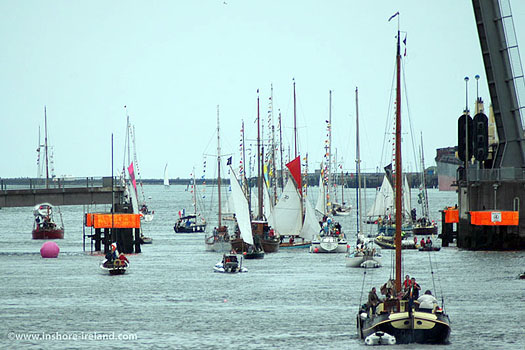
#BrazilianTallship– A Brazilian Navy sail training vessel NSV Cisne Branco docked in Dublin Port this lunchtime, her call bringing back memories to last year's hosting of the Tall Ship Race Festival, writes Jehan Ashmore.
On her arrival, the Dutch built Cisne Branco ("white swan") which is three-masted full-rigged ship and only launched in 1999 passed a pair of other tallships. They are the Johanna Lucretia and Irene (previously Irene of Bridgewater) which are also making a weekend visit while moored at the Poolbeg YC & Marina.
The pair are visiting the capital as part of a series of Tallship 'Gathering' events organised by Sail Training Ireland and held throughout the summer, and where the Poolbeg facility is to host the inaugural Dublin Port River Festival on the June Bank holiday.
Cisne Branco transited through the East-LinK toll-bridge and berthed at Sir John Rogerson Quay where the 2,991 tonnes luxury charter motoryacht Lauren L has in recent days shifted berths within the port.
Also berthed nearby the L.E. Aisling (P23), the final member of the trio of 'Emer' class OPV's which are an improved version of the 'Deirdre' . As previously reported on Afloat.ie, the leadship L.E. Emer is to be sold along with L.E. Aoife.
Two Class B Tall Ships will arrive in Dublin Port today as part of a "Gathering Ireland 2013" project organised by Sail Training Ireland and their Liverpool Based partner "Merseyside Adventure Sailing Trust". The first ship, Irene of Bridgewater, sailed in last night and anchored in Scotsman's Bay just as the Queen Mary 2 departed.
The ships are being hosted by Poolbeg Marina and tomorrow morning at 11.00am an Irish-Coffee reception is organised on board. If you are interested in Tall Ships or perhaps a future voyage, this is your chance to come along and see the ships first hand.
Irene is a West Country Trading Ketch, built in 1907 by FJ Carver and Sons.Owned by the same family since 1965, Irene has sailed extensively around the Caribbean, the Mediterranean and UK waters. Following a complete rebuild lasting six years, Irene is now earning her keep as both a sail training vessel and a sustainable cargo business. She also attends many of the major sailing events on the annual regatta and festival calendar.
The project entitled "Sail Home To Your Roots" involves two ships and 16 novice-sailors aged from 16 to 70 years from the UK. Some of the participants are of Irish descent and sail here to celebrate their Irish roots.
The ships will arrive at Poolbeg Yacht and Boat Club between 2 and 3pm today. Tomorrow morning, Councillor Paddy Bourke of Dublin City Council will officially welcome the crews to Dublin. Cllr. Bourke will be representing The Lord Mayor of Dublin, Cllr. Naoise O Múirí who is Admiral of Dublin Port and a very strong supporter of Sail Training Ireland's activities.
This event is a pre-cursor to a larger event on the June bank holiday weekend where these two ships will be joined by 2 larger Class A Tall Ships and another Class B to take part in the Dublin Port River Festival being organised by Dublin Port Company.




























